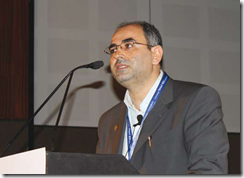The annual Telco World Summit in Dubai gathers many of the Middle East’s operator community under a single roof to assess the overall state of the market. The event’s key themes were centred around customer acquisition and retention efforts, as well as how best to open new revenue streams while cutting back on infrastructure spending. Recurring themes as these may be, fresh from the sting of the economic slowdown, operators are looking at their businesses more critically with the view to preserving operating margins
Telecom World Summit 2009 had operators assessing whether the worse effects of the economic slowdown are now behind us
Oman has five licensed resellers cramped into a market with an addressable potential of around three million users. It shall be interesting to witness just how many of these resellers survive beyond their first couple of years of operation. Three of the five – Friendi Mobile, Renna, and Mazoon – are operational, with the remaining two set to launch in H110.
As the first country in the Gulf to introduce reseller services of this nature, Oman has been held up as an example of what the impact of such a competitive regime may have on the market; with participants in places such as Jordan, Bahrain and Saudi Arabia all checking the progress in respect to what may occur when and if such services are offered in their own markets.
Jordan’s network operators have been vociferous in their objection to having to answer to all reseller/MVNO applications should they sign an agreement with one, and the Omani example does little to allay fears that network operators will end up being landed with more resellers than are commercially viable. Oman’s Nawras has agreements in place with three resellers while Oman Mobile has deals with two of them, and it remains to be seen how these niche players will differentiate their services and achieve critical mass.
 Given the presence of three existing resellers in Oman, as well as a further subbrand launched by Friendi in collaboration with a local Omani radio station, the prospects for further development of this market niche appear limited.
Given the presence of three existing resellers in Oman, as well as a further subbrand launched by Friendi in collaboration with a local Omani radio station, the prospects for further development of this market niche appear limited.
“The point is we will need to differentiate,” commented Mohamed Al Hashili, CEO of Mazoon Mobile talking at Telco World Summit. “There is already a lot of activity in the market and we need build to a relationship with customers that they do not already have with any of our competitors,” he added without offering any specific examples.
Another issue likely to affect Oman’s resellers is the fact that projected ARPU levels are understood to be lower than initially anticipated, resulting in the requirement for more subscribers to need to be added to their services in order for the operations to break even.
“While we have been surprised and delighted by the number of subscribers we have been able to add since launch, I will say that we are slightly behind or just on par on ARPU levels,” Niklas Nielsen, board advisor at Majan Telecom, the parent company of Renna, said. “Despite this, we shall become cash flow positive in 2010.”
Independent consultants have estimated that it will now take the addition of 170,000-200,000 subscribers in order for a reseller in Oman to become profitable, when that figure had originally been estimated at around 100,000. It is highly unlikely that all five resellers will be able to reach such numbers, suggesting two or more of them are likely to go out of business within the life-span of their five-year licences.
As important as the issue of service differentiation, if not more so, is the matter of customer retention efforts in the Middle East, as subscriber growth flattens or falls. MTN Yemen CEO , Raed Ahmad estimates the average cost of churn in his market at as much as US$8.50 per line, including the cost of the SIM and packaging, distribution commissions, and lost opportunity amongst other things.
 Mehdi Otoofi, MCI Iran’s chief marketing officer confirmed that Iran operates the largest post-paid market in the region
Mehdi Otoofi, MCI Iran’s chief marketing officer confirmed that Iran operates the largest post-paid market in the region
“Operators must have tools in place that continuously monitor usage patterns,” Ahmad said, highlighting one of the factors that allowed MTN Yemen to lower its churn rate from six per cent in August 2008, down to 3.4 per cent.
Thus the operator has witnessed a reduction in churn of 45 per cent in just two years. Five operators are present in Yemen, a country with a population of 23.4 million and a mobile penetration rate forecast to reach 30.7 per cent in 2010. This penetration level is set to rise further to 51.9 per cent by 2014. MTN Yemen’s active response to and arrest of its high churn has helped the operator garner a 39.4 per cent market share, counting 2.3 million subscribers at the end of September 2009, and representing a 23.1 per cent year-on-year increase.
“Operators really need to start valuing prepaid customers as much as they do post-paid users,” Ahmad advised. “MTN Yemen launched service in 2001, and one of the strategies of our loyalty programme was to look after old soldiers first, and reward them with bonuses.”
What has become abundantly clear is that it costs less to keep subscribers on the network through loyalty offers than it does to go out and purchase new customers that might have churned.
“In this time of growing competition, operators need to place additional concentration on market intelligence, and on products and services,” Ahmad concluded.
The move by telecom operators into areas that are not their traditional areas of activity such as the Internet and financial services is a trend that is building greater momentum as the need to generate incremental cash increases. Robert Waaler, product management, business unit Device Management at SmartTrust revealed that we now exist in a time when there are more connections to the Internet made via mobile than via fixed PC. He identified six building blocks for mobile applications, which are:
 • Ease of use
• Ease of use
• Personalised
• Clear billing
• Open
• Evolving
• Quick return on investment
Given that an estimated 85 per cent of the world remains unbanked, while more than half of the world’s population owns or has access to a mobile device, the incentive for mobile operators to consider ways in which to offer banking and financial services becomes more apparent. Mobile financial services can be divided into three main categories:
• Mobile banking
• Mobile payment (which targets the unbanked)
• Mobile money transfer
The key elements for the successful implementation of mobile financial services include easy registration; simple and easy interface; the ability for interactivity; and the enablement of portability.
“The architecture of mobile financial networks needs to be compliant with regulations; highly secure, and offer a flexible system that is future-proof,” Waaler commented.
On the part of operators, the crucial roles they can play in establishing mobile financial services as a successful part of their offering includes implementing a strong marketing campaign; building awareness; educating users about the service, and creating trust for the service.
“Security and regulation ought to be at the forefront of developments from the beginning,” Waaler cautioned.






0 comments ↓
There are no comments yet...Kick things off by filling out the form below.
Leave a Comment